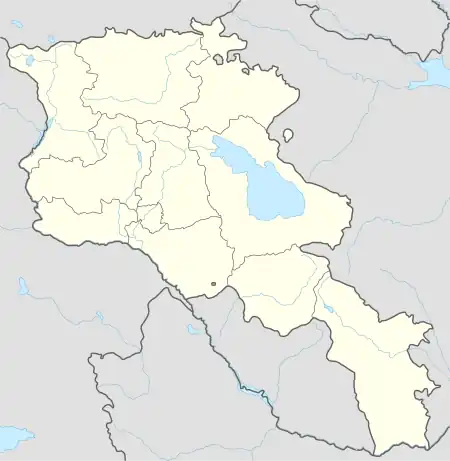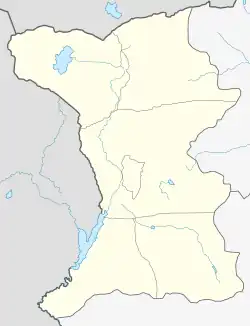Amasia
Ամասիա | |
|---|---|
 | |
 Amasia  Amasia | |
| Coordinates: 40°56′48″N 43°46′53″E / 40.94667°N 43.78139°E | |
| Country | Armenia |
| Province | Shirak |
| Municipality | Amasia |
| Elevation | 1,870 m (6,140 ft) |
| Population | |
| • Total | 1,532 |
| Time zone | UTC+4 |
| Amasia, Shirak at GEOnet Names Server | |
Amasia (Armenian: Ամասիա), previously known as Hamasia,[2] is a village in the Amasia Municipality of the Shirak Province of Armenia. It is located on the right bank of the Akhuryan River.
Etymology
Amasia's name is traditionally connected with the name of Amasia Haykazuni, a great-grandson of Hayk, the legendary progenitor of the Armenians.[3]
History
Historically, the area that Amasia is located in was a part of the canton of Ashotsk of the province of Gugark of the ancient Kingdom of Armenia.[3] Approximately two kilometers to the northwest of the village is a ruined ancient fortress built in Cyclopean style that the villagers refer to as Chatin Dara, dated to approximately the 3–2 millennia BCE.[2][3] Two kilometers to the west of the village is an abandoned settlement that the villagers call Kharabalar, which according to folk tradition was inhabited by Greeks.[3] There are also a number of medieval Armenian churches in the area around the village.[3] Most of the current inhabitants of Amasia and the nearby villages are descended from Armenians who came from Basen and Kars and other parts of Western Armenia starting from 1829, when Eastern Armenia was conquered by the Russian Empire.[2] Until the 1920s the core village of Amasia was populated almost entirely by Turkic-speaking Sunni Muslims (Qarapapaqs).[4] According to the 1912 edition of the Caucasian Calendar reference book, 528 people, mainly Qarapapaqs, lived in Amasia, then located in the Kars Okrug of the Kars Oblast of the Russian Empire.[5] By 1931, Armenians outnumbered the Turkic population, and eventually the village became exclusively Armenian-populated.[4]
In 1893, the British explorer and author of a two volume work on Armenia, H. F. B. Lynch, visited the village.[2] During Soviet times, Amasia was the capital of the Amasia District of Soviet Armenia. From 1951–1956 the village was officially known as Ghukasyan (or Ghukasyan Nerkin to distinguish it from Ashotsk, then also called Ghukasyan), after the Armenian Young Communist Ghukas Ghukasyan who died during the May Uprising.[2]
Amasia is the center of the municipality (enlarged rural community) of Amasia, which, as of 2023, encompasses 25 other villages: Aregnadem, Bandivan, Byurakn, Gtashen, Kamkhut, Hovtun, Voghji, Hoghmik, Meghrashat, Jradzor, Alvar, Aghvorik, Ardenis, Garnarij, Lorasar, Darik, Yeghnajur, Aravet, Zarishat, Tsaghkut, Shaghik, Zorakert, Berdashen, Yerizak, and Paghakn.[6]
Climate
| Climate data for Amasia, Shirak (1981–2010) | |||||||||||||
|---|---|---|---|---|---|---|---|---|---|---|---|---|---|
| Month | Jan | Feb | Mar | Apr | May | Jun | Jul | Aug | Sep | Oct | Nov | Dec | Year |
| Record high °C (°F) | 6.3 (43.3) |
7.6 (45.7) |
16.9 (62.4) |
22.6 (72.7) |
24.9 (76.8) |
29.5 (85.1) |
33.0 (91.4) |
33.0 (91.4) |
31.5 (88.7) |
24.0 (75.2) |
16.0 (60.8) |
12.9 (55.2) |
33.0 (91.4) |
| Mean daily maximum °C (°F) | 1.6 (34.9) |
3.1 (37.6) |
8.8 (47.8) |
17.2 (63.0) |
21.2 (70.2) |
25.0 (77.0) |
28.6 (83.5) |
28.8 (83.8) |
25.1 (77.2) |
19.9 (67.8) |
12.1 (53.8) |
4.6 (40.3) |
16.4 (61.5) |
| Daily mean °C (°F) | −8.3 (17.1) |
−7.0 (19.4) |
−2.5 (27.5) |
4.4 (39.9) |
9.1 (48.4) |
13.3 (55.9) |
16.7 (62.1) |
16.9 (62.4) |
13.0 (55.4) |
7.2 (45.0) |
0.4 (32.7) |
−5.4 (22.3) |
4.8 (40.6) |
| Mean daily minimum °C (°F) | −20.5 (−4.9) |
−19.8 (−3.6) |
−16.6 (2.1) |
−7.4 (18.7) |
−1.7 (28.9) |
2.8 (37.0) |
6.5 (43.7) |
6.7 (44.1) |
1.1 (34.0) |
−4.3 (24.3) |
−11.3 (11.7) |
−17.8 (0.0) |
−6.9 (19.6) |
| Record low °C (°F) | −25.7 (−14.3) |
−28.1 (−18.6) |
−25.9 (−14.6) |
−15.5 (4.1) |
−6.0 (21.2) |
−2.3 (27.9) |
1.9 (35.4) |
2.6 (36.7) |
−5.4 (22.3) |
−7.7 (18.1) |
−21.4 (−6.5) |
−23.8 (−10.8) |
−28.1 (−18.6) |
| Average precipitation mm (inches) | 36.2 (1.43) |
42.4 (1.67) |
45.1 (1.78) |
80.6 (3.17) |
98.5 (3.88) |
84.1 (3.31) |
51.8 (2.04) |
43.7 (1.72) |
29.3 (1.15) |
51.9 (2.04) |
44.9 (1.77) |
39.3 (1.55) |
647.8 (25.50) |
| Average precipitation days (≥ 1.0 mm) | 7.1 | 6.7 | 8.5 | 11.6 | 15.0 | 11.4 | 8.4 | 7.7 | 5.3 | 7.4 | 7.0 | 7.2 | 103.6 |
| Source: World Meteorological Organization[7] | |||||||||||||
Population
The population of the village since 1886 is as follows:[8]
| Year | Population | Note |
|---|---|---|
| 1886 | 274 | |
| 1908[9] | 507 | Mainly Karapapakh |
| 1914 | 564 | |
| 1931 | 645 | |
| 1939[10] | 1,031 | 568 Armenians, 424 Azerbaijanis, 33 Russians, 6 others |
| 1959 | 1,527 | |
| 1970 | 2,773 | |
| 1980 | 3,175 | |
| 2001 | 1,878 | |
| 2004 | 1,941 | |
| 2011 | 1,532[1] |
References
- 1 2 "Population Census 2011: Distribution of RA De facto and De jure Population by RA administrative-territorial units" (PDF). Statistical Committee of the Republic of Armenia. 2011. Retrieved 26 July 2023.
- 1 2 3 4 5 Hakobyan, Tadevos Kh.; Melik-Bakhshyan, Stepan T.; Barseghyan, Hovhannes Kh. (1986). Ամասիա. Հայաստանի և հարակից շրջանների տեղանունների բառարան [Dictionary of toponymy of Armenia and adjacent territories] (in Armenian). Vol. 1. Yerevan: Yerevan State University Publishing House. p. 208.
- 1 2 3 4 5 "Պատմական ակնարկ Ամասիայի և հարակից բնակավայրեր մասին" [Historical review of Amasia and nearby settlements]. amasia.am. Amasia Community of Shirak Province (official website). Archived from the original on 4 April 2019.
- 1 2 "Ամասիա ավանի բնակչությունը 1886-2013 թվականներին" [Population of the settlement Amasia from 1886-2013]. ANI Armenian Research Center (in Armenian). 10 June 2021. Archived from the original on 24 June 2021. Retrieved 24 June 2021.
- ↑ "Кавказский календарь. Тифлис 1912". Archived from the original on 4 March 2016. Retrieved 25 November 2012.
- ↑ Համայնքի անձնագիր [Community's ID]. amasia.am. Archived from the original on 26 July 2023. Retrieved 26 July 2023.
- ↑ "World Meteorological Organization Climate Normals for 1981–2010". World Meteorological Organization. Archived from the original on 10 October 2021. Retrieved 10 October 2021.
- ↑ Հայաստանի Հանրապետության բնակավայրերի բառարան [Republic of Armenia settlements dictionary] (PDF) (in Armenian). Yerevan: Cadastre Committee of the Republic of Armenia. 2008. Archived from the original (PDF) on 11 March 2018.
- ↑ Кавказский календарь на 1910 год [Caucasian calendar for 1910] (in Russian) (65th ed.). Tiflis: Tipografiya kantselyarii Ye.I.V. na Kavkaze, kazenny dom. 1910. p. 181. Archived from the original on 15 March 2022.
- ↑ "Демоскоп Weekly - Приложение. Всесоюзная перепись населения 1939 года". www.demoscope.ru. Retrieved 10 October 2022.
